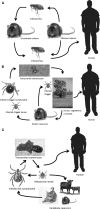Rickettsial infections in Southeast Asia: implications for local populace and febrile returned travelers
- PMID: 24957537
- PMCID: PMC4155544
- DOI: 10.4269/ajtmh.14-0191
Rickettsial infections in Southeast Asia: implications for local populace and febrile returned travelers
Abstract
Rickettsial infections represent a major cause of non-malarial febrile illnesses among the residents of Southeast Asia and returned travelers from that region. There are several challenges in recognition, diagnosis, and management of rickettsioses endemic to Southeast Asia. This review focuses on the prevalent rickettsial infections, namely, murine typhus (Rickettsia typhi), scrub typhus (Orientia tsutsugamushi), and members of spotted fever group rickettsiae. Information on epidemiology and regional variance in the prevalence of rickettsial infections is analyzed. Clinical characteristics of main groups of rickettsioses, unusual presentations, and common pitfalls in diagnosis are further discussed. In particular, relevant epidemiologic and clinical aspects on emerging spotted fever group rickettsiae in the region, such as Rickettsia honei, R. felis, R. japonica, and R. helvetica, are presented. Furthermore, challenges in laboratory diagnosis and management aspects of rickettsial infections unique to Southeast Asia are discussed, and data on emerging resistance to antimicrobial drugs and treatment/prevention options are also reviewed.
© The American Society of Tropical Medicine and Hygiene.
Figures



References
-
- Bottieau E, Clerinx J, Schrooten W, Van den Enden E, Wouters R, Van Esbroeck M, Vervoort T, Demey H, Colebunders R, Van Gompel A. Etiology and outcome of fever after a stay in the tropics. Arch Intern Med. 2006;166:1642–1648. - PubMed
Publication types
MeSH terms
Substances
LinkOut - more resources
Full Text Sources
Other Literature Sources
Medical

